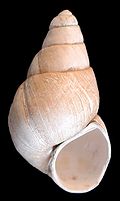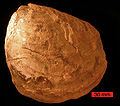
Index fossil
Encyclopedia

Fossil
Fossils are the preserved remains or traces of animals , plants, and other organisms from the remote past...
s used to define and identify geologic periods (or faunal stages). They work on the premise that, although different sediment
Sediment
Sediment is naturally occurring material that is broken down by processes of weathering and erosion, and is subsequently transported by the action of fluids such as wind, water, or ice, and/or by the force of gravity acting on the particle itself....
s may look different depending on the conditions under which they were laid down, they may include the remains of the same species
Species
In biology, a species is one of the basic units of biological classification and a taxonomic rank. A species is often defined as a group of organisms capable of interbreeding and producing fertile offspring. While in many cases this definition is adequate, more precise or differing measures are...
of fossil. If the species concerned were short-lived (in geological terms, lasting a few hundred thousand years), then it is certain that the sediments in question were deposited within that narrow time period. The shorter the lifespan of a species, the more precisely different sediments can be correlated, and so rapidly evolving types of fossils are particularly valuable. The best index fossils are common, easy-to-identify at species level, and have a broad distribution—otherwise the likelihood of finding and recognizing one in the two sediments is minor.
Ammonite
Ammonite
Ammonite, as a zoological or paleontological term, refers to any member of the Ammonoidea an extinct subclass within the Molluscan class Cephalopoda which are more closely related to living coleoids Ammonite, as a zoological or paleontological term, refers to any member of the Ammonoidea an extinct...
s fit these demands well, and are the best-known fossils that have been widely used for this. Other important groups that provide index fossils are the coral
Coral
Corals are marine animals in class Anthozoa of phylum Cnidaria typically living in compact colonies of many identical individual "polyps". The group includes the important reef builders that inhabit tropical oceans and secrete calcium carbonate to form a hard skeleton.A coral "head" is a colony of...
s, graptolite
Graptolite
Graptolithina is a class in the animal phylum Hemichordata, the members of which are known as Graptolites. Graptolites are fossil colonial animals known chiefly from the Upper Cambrian through the Lower Carboniferous...
s, brachiopod
Brachiopod
Brachiopods are a phylum of marine animals that have hard "valves" on the upper and lower surfaces, unlike the left and right arrangement in bivalve molluscs. Brachiopod valves are hinged at the rear end, while the front can be opened for feeding or closed for protection...
s, trilobite
Trilobite
Trilobites are a well-known fossil group of extinct marine arthropods that form the class Trilobita. The first appearance of trilobites in the fossil record defines the base of the Atdabanian stage of the Early Cambrian period , and they flourished throughout the lower Paleozoic era before...
s, and echinoids (sea urchin
Sea urchin
Sea urchins or urchins are small, spiny, globular animals which, with their close kin, such as sand dollars, constitute the class Echinoidea of the echinoderm phylum. They inhabit all oceans. Their shell, or "test", is round and spiny, typically from across. Common colors include black and dull...
s). Conodont
Conodont
Conodonts are extinct chordates resembling eels, classified in the class Conodonta. For many years, they were known only from tooth-like microfossils now called conodont elements, found in isolation. Knowledge about soft tissues remains relatively sparse to this day...
s may be identified by experts using light microscopy
Microscopy
Microscopy is the technical field of using microscopes to view samples and objects that cannot be seen with the unaided eye...
such that they can be used to index a given sample with good resolution. Fossilized teeth of mammal
Mammal
Mammals are members of a class of air-breathing vertebrate animals characterised by the possession of endothermy, hair, three middle ear bones, and mammary glands functional in mothers with young...
s have also been used.
Geologist
Geologist
A geologist is a scientist who studies the solid and liquid matter that constitutes the Earth as well as the processes and history that has shaped it. Geologists usually engage in studying geology. Geologists, studying more of an applied science than a theoretical one, must approach Geology using...
s use both large fossils (called macrofossils) and microscopic fossils (called microfossils) for this process, known as biostratigraphy
Biostratigraphy
Biostratigraphy is the branch of stratigraphy which focuses on correlating and assigning relative ages of rock strata by using the fossil assemblages contained within them. Usually the aim is correlation, demonstrating that a particular horizon in one geological section represents the same period...
. Macrofossils have the advantage of being easy to see in the field, but they are rarer, and microfossils are very commonly used by oil
Petroleum
Petroleum or crude oil is a naturally occurring, flammable liquid consisting of a complex mixture of hydrocarbons of various molecular weights and other liquid organic compounds, that are found in geologic formations beneath the Earth's surface. Petroleum is recovered mostly through oil drilling...
prospectors and other industries interested in mineral
Mineral
A mineral is a naturally occurring solid chemical substance formed through biogeochemical processes, having characteristic chemical composition, highly ordered atomic structure, and specific physical properties. By comparison, a rock is an aggregate of minerals and/or mineraloids and does not...
resources when accurate knowledge of the age of the rocks being looked at is needed.
| Fossil | Scientific Name | Time Period | Million Years Ago |
|---|---|---|---|
 Calico Scallop |
Pecten gibbus Argopecten gibbus Atlantic calico scallop The Atlantic calico scallop, Argopecten gibbus, is a species of medium-sized edible saltwater clam, specifically a scallop, a marine bivalve mollusk in the family Pectinidae, the scallops.... |
Quaternary Period | |
| Neptunea tabulata | Quaternary Period | ||
 |
Viviparus glacialis Viviparus glacialis †Viviparus glacialis is an extinct species of fossil freshwater snail, an aquatic gastropod mollusks in the family Viviparidae.-Shell description:... |
Tiglian (Early Pleistocene Early Pleistocene Calabrian is a subdivision of the Pleistocene Epoch of the Geologic time scale. ~1.8 Ma.—781,000 years ago ± 5,000 years, a period of ~.The end of the stage is defined by the last magnetic pole reversal and plunge in to an ice age and global drying possibly colder and drier than the late Miocene ... ) |
|
| Calyptraphorus velatus | Tertiary Period | ||
| Venericardia planicosta | Eocene Eocene The Eocene Epoch, lasting from about 56 to 34 million years ago , is a major division of the geologic timescale and the second epoch of the Paleogene Period in the Cenozoic Era. The Eocene spans the time from the end of the Palaeocene Epoch to the beginning of the Oligocene Epoch. The start of the... |
||
 Scaphites Scaphites Scaphites is a genus of extinct cephalopod belonging to the family of heteromorph ammonites . They were a widespread genus that thrived during the Cretaceous period.... |
Scaphites hippocrepis | Cretaceous Period | |
 Inoceramus Inoceramus Inoceramus is an extinct genus of fossil marine pteriomorphian bivalves that superficially resembled the related winged pearly oysters of the extant genus Pteria.... |
Inoceramus labiatus | Cretaceous Period | |
| Perisphinctes Perisphinctes Perisphinctes is an extinct genus of ammonite cephalopod. They lived during the Jurassic Period , and serve as an index fossil for that time period.... |
Perisphinctes tiziani | Jurassic Period | |
| Nerinea trinodosa | Jurassic Period | ||
| Tropites subbullatus | Triassic Period | ||
| Monotis subcircularis | Triassic Period | ||
Leptodus |
Leptodus americanus | Permian Period | |
| Parafusulina Parafusulina Parafusulina is a genus of fusulinids, a group of extinct protozoans.... |
Parafusulina bosei | Permian Period | |
| Dictyoclostus americanus | Pennsylvanian Period | ||
| Lophophyllidium proliferum | Pennsylvanian Period | ||
| Cactocrinus multibrachiatus | Mississippian Period | ||
| Prolecanites gurleyi | Mississippian Period | ||
 Mucrospirifer Mucrospirifer Mucrospirifer is a genus of extinct brachiopod in the class Rhynchonellata and the order Spiriferida. They are sometimes known as "butterfly shells". Like other brachiopods, they were filter feeders. These fossils occur mainly in Middle Devonian strata.The biconvex shell was typically 2.5 cm,... |
Mucrospirifer mucronatus | Devonian Period | |
| Palmatolepis unicornis | Devonian Period | ||
| | | Silurian Period | ||
| Tetragraptus fructicosus | Ordovician Period | ||
| Paradoxides Paradoxides Paradoxides was a genus of relatively large trilobites found throughout the world during the Mid Cambrian period .... |
Cambrian Period | ||
| Billingselia corrugata | Cambrian Period | ||
| Archeocyathids | Lower Cambrian |

